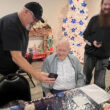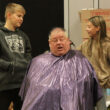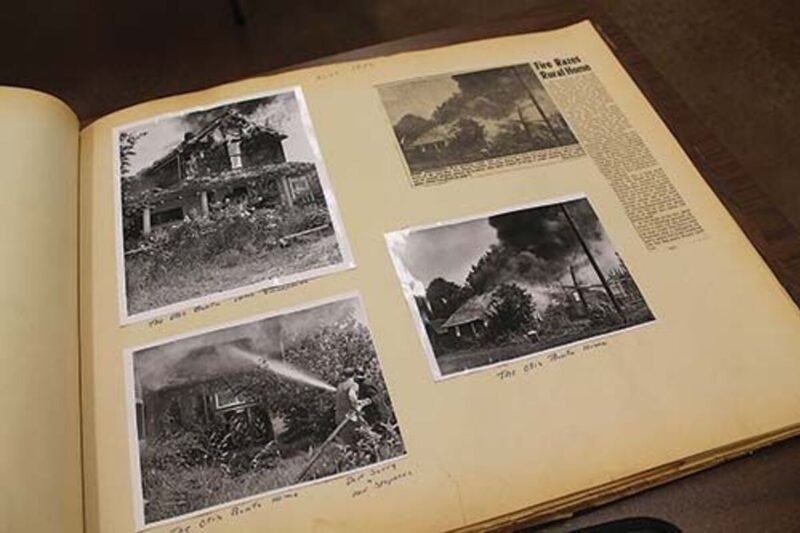Sean C. Morgan
The Sweet Home Fire and Ambulance District will celebrate the Sweet Home Fire Department’s 75th anniversary with an open house Saturday, Sept. 12.
The event will run from 10 a.m. to 3 p.m. The district will provide hot dogs, drinks and chips, as well as demonstrations of extrication and high-rise spraying. Firefighters will provide a fire engine ride. Children will also get the chance to spray a fire hose. Rappelling and scuba demonstrations also may be on the agenda.
A 4-foot-by-8-foot airbrushed mural will be unveiled during the open house.
“It’s for our 75th anniversary,” said Fire Chief Dave Barringer.
Technically, 2014 was the department’s 75th year, as Sweet Home established the Fire Department in 1939. But some big changes in the department leadership occurred last year, with Barringer taking over for longtime chief Mike Beaver and other retirement occurring.
“We’re getting to it now,” Barringer said.
“The first station was a Quonset hut,” he said. “It’s pretty amazing, the progression to the station at City Hall.”
The city knocked that one down and built the existing Fire Hall in 1994.
Joe Mengore, the first paid chief, led the department through that transition, and did a lot to help make the transition from a city department, with a Sweet Home Rural Fire District and an Ambulance District, to a stand-alone district.
In all that time, the department has progressed from an all-volunteer service, with medical services provided through the Police Department, to a regular professional paid staff that includes six paramedics, three battalion chiefs, a chief and an administrative assistant with an additional 10 part-time medics.
Today, the district is pushing a call load of 3,000 per year, nearly all of those medical calls.
Barringer remembers chiefs Ivan Hoy and Gerry Wooley as well as members such as Ron Fogle and Blair Smith, who helped “define how the fire department grew.”
Mengore had a big hand in guiding that growth and making sure the department met current standards.
The longest-running member of the department today is Dave Trask, who first volunteered in 1972. Doug Emmert also is among those with a long history in the department.
Emmert, a retired battalion chief, has continued to volunteer. He first joined the service in 1977 as a volunteer emergency medical technician. The Fire Department had one paid firefighter then, Ron Fogel. The chief was a volunteer. Fogel was assistant chief.
Emmert tested for a paid medic position in 1979 after Terry Brooks left, and Emmert worked for police chiefs Orville Pound and Ed Savage. He worked with Dale Miner and Diane Shank, the department’s first female medic, who later became the administrative assistant before retiring two years ago.
As a medic, Emmert was part of the Police Department, which had three paid medics on staff at the time.
“At that time, they really tried to keep the emergency medical service part separated from the Fire Department,” Emmert said. The philosophy was that someone couldn’t do two different jobs, even though they really were anyway.
As buildings got newer, fires became less common, Emmert said, and it became more difficult to justify having personnel only fight fires.
Emmert got onto the Fire Department as a volunteer in the early 1980s, he said. “They started to let a few of us on.”
He left Sweet Home temporarily in 1985 to take a position in Albany, but he stayed on as a volunteer and became chairman of the Sweet Home Ambulance District Board of Directors.
Mengore was chief, Emmert said, and it was in the late 1980s and early 1990s they started talking about forming a unified fire district to establish a tax base and get away from ongoing serial operating levies, Emmert said.
SHFAD officially formed in 2001.
During his tenure with the department, Emmert saw the department go from a time when it had just six or eight sets of SCBA gear. Now everyone wears them. A half dozen turnouts used to hang on the back of the engines, where the firefighters would ride to fires. Today, everyone has his or her own turnouts.
Speaking of riding on the back of an engine, Emmert recalled how tricky that was, back in the day.
“You kept your knees bent or it would launch you if you ran over a railroad track,” he said.
That’s something Battalion Chief Eli Harris, an 11-year veteran of the district, can still remember.
“Randy Whitfield grabbed me by the scruff of the neck like a stray puppy and said, ‘Strap in,’” Harris said. He shoved Harris onto the back of the engine.
Nick Tyler warned him to keep his knees bent, Harris said. He found out why when a deer jumped out in front of the engine on the way to a fire. Dennis Huenergardt was driving and hit the brakes hard in a hurry. Harris said he almost landed in the hose bed.
Harris said he rode the back of an engine maybe 15 times. The district no longer uses engines like that.
Overall, the service is much more safety-conscious, Emmert said. Those engines aren’t even available any more. Training is more rigorous too.
Such improvements come with experience, veterans said. In the past, no one knew any better about some of the department’s practices, Emmert said. Some of the younger guys were working at departments around the valley and volunteering here. They’d bring what they learned back with them through the 1970s and 1980s.
The department added a water rescue program and boat after a call in the 1980s in which a father and son fell into Quartzville Creek. The son got out, but the father drowned. First responders had to wait hours for the sheriff’s boat to get here.
“We had a fund-raising campaign to buy our first boat,” Emmert said, noting that was typical for Sweet Home.
“The community’s always been very supportive of the fire and ambulance (service),” he said.





